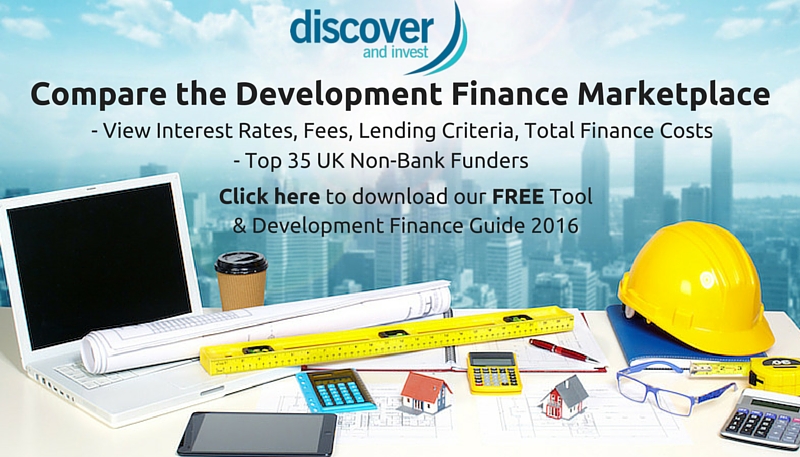This excerpt is taken from our recently launched Development Finance Guide, and provides property developers with 4 unique insights (out of 11 in the Guide) into the Development Finance marketplace today:
1. Why selecting Lenders by their Interest Rate is an inaccurate & misleading practice
Most will understand that the headline rate offered by any lender is designed to get your attention but comes with some form of caveat. But lenders do it because they know one thing that works: most prospective borrowers select their lenders, at least initially, according to who has the cheapest looking interest rate. The bad news is it’s probably costing you a lot of money. The good news is we have a free tool that compares lenders correctly for you (which we will introduce later).
The funding selection problem arises because borrowers we speak to feel they don’t have full sight of the marketplace. Unlike the residential mortgage space, where products are fixed and visible, there is not a decent equivalent option for businesses and in particular property developers.
A few lenders are usually found randomly, and in a bid to narrow options down quickly, borrowers start going with the one or two that seem to be the cheapest i.e. the lowest advertised interest rate. It’s a question of trying to select your best lenders too quickly, when a slightly more detailed process will provide significant cost savings. Do you want to select them quickly, and cost you money, or save yourself thousands with a slightly longer, fresher approach?
The two key insights into rate are 1) an interest rate can be calculated 3 different ways and 2) depending on the fee structure, interest can make up as little as 50% of your overall finance costs!
1) We can show you 3 different lenders with a 7% per annum interest rate, and if they are all calculated differently, will give you 3 wildly different amounts of interest (before we even look into fee structures)
2) Most funders have arrangement and exit fees, but some now have exit fees as a % of the GDV not the loan, which adds at least 50% on the exit fee. Some 7% per annum funders come out as expensive at 15% annualised in the end.
2. Bridgers v. APR Lenders: the surprising verdict on who is cheapest
Whilst it is important to understand how expensive some cheap looking lenders are, it is also important not to rule out lenders that initially look expensive.
It is common for a borrower to look at a monthly “bridging” interest rate of 1% per month and decide it’s 12% per annum and too expensive.
But is it? Not if the rate is calculated on drawdowns..
If the rate is calculated on the drawn balance not the facility, the annualised rate is nearer 7.5% based on a 12-month loan and 9 equal drawdowns. Some bridgers also have very low or zero exit fees, and so what happens quite frequently now is that the initially cheap development funder at 7% (but with a 2% arrangement and 1-2% of GDV exit fee), is the same overall cost as the bridger at 1% per month.
For those that don’t like paying exit fees, and don’t like the idea of a GDV based exit fee as a variable, the bridge sometimes becomes the preferred route.
If the loan is likely to be over 12 months, it may be that bridger does become increasingly expensive, usually after around 15 months, as their monthly rate is essentially double that of the development lender, pro-rata.
If the loan is under 12 months though, for deals like Permitted Development Schemes, it is well worth comparing one or two of the cheaper bridgers with more mainstream lenders.
There are pro’s and con’s to both but hopefully you can see that one type of lender that would have always been ruled out, actually comes into consideration and in many cases, can be the preferred solution.
3. Assess Lenders by % Loan to GDV and % Loan to Cost first
A further note on assessing lenders is the understanding of the other key components at play bar rate, and whether they are drivers for your developments.
Some developers are not so bothered by rate as they are the minimum cash stake levels to go in, either because they have low cash levels, or because they wish to deploy the cash they have across multiple projects simultaneously.
Lenders with a higher maximum Loan to GDV %, and those with a higher maximum Loan to Cost %, will typically allow developers to borrow more money and put less down. They are NOT though, always the cheapest rate lenders. The cheapest rate lenders usually want more cash levels going in, so it is a balancing act between how much interest you will pay and how cash you have to put down on Day 1. Again you may find the preferred lender is not the one you thought when comparing properly.
If you are yet to buy a site, it is worth going through this process first, so you know how much you need to put down, what’s the maximum site price you can aim for, and what loan you require as a % of the GDV so you can rule in or out a number of lenders.
4. How to get funding without your own deposit/equity stake
You may be a developer without any cash, and wondering if you can get a project off the ground at all. There are a number of ways to do this:
• Some lenders will allow you to put down zero cash if you have a strong asset position behind you. If you have a substantial property portfolio, some lenders will take charges over various properties to the amount they deem secure enough for them to lend.
• Bring an equity investor on board who will provide the cash cover and asset position for you. There are now many angel investor and crowd funding websites, where property is not only the most popular form of investment, but also some of these sites specifically cater to property investing. Type “property crowdfunding” or “equity crowdfunding” into Google and you should get most of the right websites quickly.
• Pre-sell units to off-plan investors. A model that works with some lenders is to partner up with an investment company who will sell units for you. They take non-refundable, exchanged deposits, and some lenders allow you to use it as at least part of your cash stake. Credit policies have tightened on this recently, so you may still need to fund part of the cash requirement. In the worst case, lenders allow you to put those funds back into the facility, reducing your financing costs going forward.
• Pre-sell the whole site to a Housing Association or Fund, which if the deal is right, can negate the need for funding at all (to be covered shortly).
• Partner with Funds or Asset Managers that will bring 100% of the funding on a Joint Venture basis, with profits split at the end. There are a good number of these companies around with multi-million Pound budgets looking to partner with developers.
* This is an excerpt taken from our Development Finance Guide Q2 2016.
If you would like to download the Guide in full,
plus our free Marketplace Comparison Tool,
click here to get instant access*
What do you want to do now?
I want to read more articles on development finance...click here
I want more information on how this finance works...click here
I want to download your Guide and Marketplace Comparison Tool...click here
I want to make an enquiry...click here
About Chris Davidson
Chris Davidson is Managing Director of Discover & Invest Ltd.
He believes passionately in providing businesses with market-leading financial insights that have a positive impact on the bottom line. As a result, Chris helps get the best rates and terms available at any one time.
Connect with Chris on Facebook, LinkedIn and Twitter to keep abreast of the latest market offerings.







